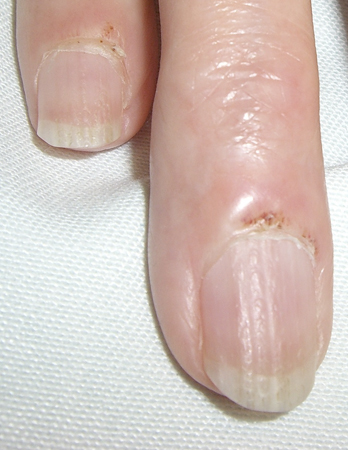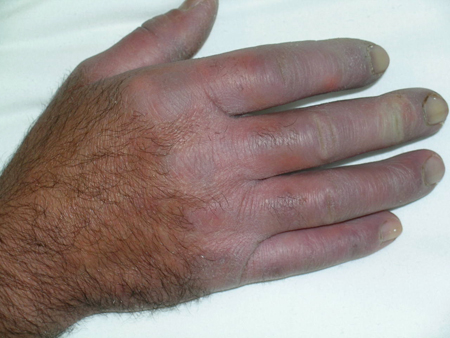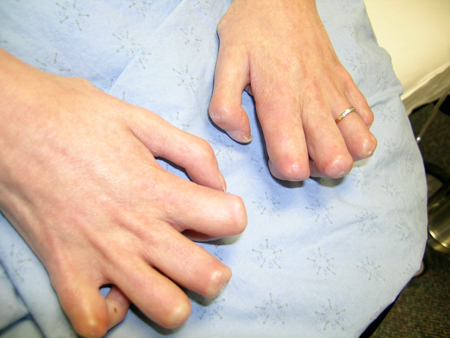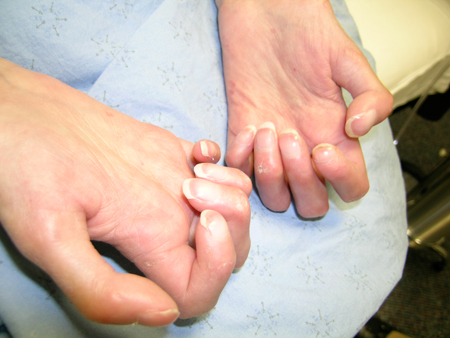History and exam
Key diagnostic factors
common
presence of risk factors
Exposure to silica dust and family history of systemic sclerosis are strong risk factors.
Raynaud's phenomenon (RP)
More than 95% of people with systemic sclerosis have RP.[24]
Common in the general population (around 5%); presence does not establish diagnosis of systemic sclerosis as most people with RP do not have an underlying connective tissue disease.[25] However, the co-existence of RP, puffy fingers with dilated nailfold capillaries, and/or positive antinuclear antibody with a scleroderma-specific pattern (centromere or nucleolar) is very likely to represent very early systemic sclerosis.[26][Figure caption and citation for the preceding image starts]: Raynaud's phenomenon in systemic sclerosis with well-demarcated white finger and blue fingersFrom the personal collection of Professor J. Pope; used with permission [Citation ends].
dysphagia
Dysphagia may not occur initially but is very common over time.
GORD
GORD may not be present initially.
dilated nailbed capillaries
Dilated capillaries are not pathognomonic.
Can occur in other connective tissue diseases (i.e., dermatomyositis). [Figure caption and citation for the preceding image starts]: Dilated capillaries at the nailbedsFrom the personal collection of Professor J. Pope; used with permission [Citation ends].
bright shiny skin of hands, feet
Shiny skin is consistent with sclerodactyly.
Also consistent with limited cutaneous systemic sclerosis, especially when extending to the elbow, face, and neck areas.
It does not extend proximally on the upper arms, thighs, or trunk.
symmetrical swelling, tight fingers
Fingers may be painfully swollen with reduced range of motion. [Figure caption and citation for the preceding image starts]: Man's hand with systemic sclerosis: note loss of hair, sclerodactyly with skin involvement proximallyFrom the personal collection of Professor J. Pope; used with permission [Citation ends].
prayer sign
The fingers of the two hands cannot touch fully when the hands are clasped together as if praying.
Due to swelling and fibrosis of tendons and contractures.
May also appear in inflammatory arthritis with deformities or diabetic hands with cheiroarthropathy. [Figure caption and citation for the preceding image starts]: Prayer sign: fingers cannot touch fully, note also digital tuft resorptionFrom the personal collection of Professor J. Pope; used with permission [Citation ends].
claw hand deformities
Claw hand results from fibrosis of the skin and subcutaneous tissues.
Claw hand deformities may also develop in patients with severe atrophy of the tendons where there is little or no flexion or extension of the fingers.
In most patients some range of motion of the knuckles is retained. [Figure caption and citation for the preceding image starts]: Systemic sclerosis with claw hand deformities (dorsal view)From the personal collection of Professor J. Pope; used with permission [Citation ends]. [Figure caption and citation for the preceding image starts]: Claw hands, palmar view; patient cannot extend fingersFrom the personal collection of Professor J. Pope; used with permission [Citation ends].
[Figure caption and citation for the preceding image starts]: Claw hands, palmar view; patient cannot extend fingersFrom the personal collection of Professor J. Pope; used with permission [Citation ends].
ulcers on fingers
Digital ulcers at fingertips or digital tuft resorption (loss of fingertip flesh).[15]
Healing with digital pits is common.
flexion contracture of hands
There may be flexion contractures present due to very little subcutaneous tissue and local trauma. [Figure caption and citation for the preceding image starts]: Multiple telangiectasia, finger flexion deformity, pits on third finger, healed ulcers on second and fourth fingersFrom the personal collection of Professor J. Pope; used with permission [Citation ends].
carpal tunnel syndrome
There may be carpal tunnel syndrome present due to hand swelling and inflammatory arthritis.
calcinosis
Chalky, toothpaste-coloured or yellowish discoloration on extensor surfaces or surfaces that rub (such as where tophi or rheumatoid nodules would occur). [Figure caption and citation for the preceding image starts]: Calcinosis on second and third fingers in systemic sclerosisFrom the personal collection of Professor J. Pope; used with permission [Citation ends].
large well-demarcated telangiectasia
May increase in size and number with increasing disease duration.
Blanchable, well-demarcated, and large.
Can occur in some other telangiectasia conditions and other connective tissue diseases. [Figure caption and citation for the preceding image starts]: Multiple telangiectasia in systemic sclerosisFrom the personal collection of Professor J. Pope; used with permission [Citation ends]. [Figure caption and citation for the preceding image starts]: Multiple telangiectasia, finger flexion deformity, pits on third finger, healed ulcers on second and fourth fingersFrom the personal collection of Professor J. Pope; used with permission [Citation ends].
[Figure caption and citation for the preceding image starts]: Multiple telangiectasia, finger flexion deformity, pits on third finger, healed ulcers on second and fourth fingersFrom the personal collection of Professor J. Pope; used with permission [Citation ends].
Other diagnostic factors
common
skin pigmentation changes
Increased and/or decreased pigmentation. [Figure caption and citation for the preceding image starts]: Diffuse cutaneous systemic sclerosis (dsSSc): tight hand and fingers, increased pigmentation, and thumb ulcerFrom the personal collection of Professor J. Pope; used with permission [Citation ends]. [Figure caption and citation for the preceding image starts]: Sclerodactyly with increased and decreased pigmentationFrom the personal collection of Professor J. Pope; used with permission [Citation ends].
[Figure caption and citation for the preceding image starts]: Sclerodactyly with increased and decreased pigmentationFrom the personal collection of Professor J. Pope; used with permission [Citation ends].
family history of connective tissue disease
First- or second-degree relatives with rheumatoid arthritis, systemic lupus erythematosus, Sjogren's syndrome, myositis, systemic sclerosis, and/or Raynaud's phenomenon.[10]
Risk factors
Use of this content is subject to our disclaimer